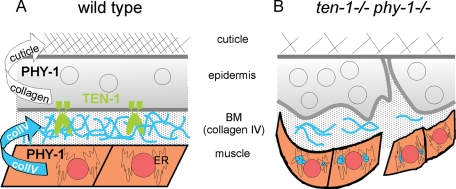FIGURE 10:
Model for the functional interaction between TEN-1 and PHY-1. (A) In wild-type C. elegans TEN-1 is expressed in the epidermis and presumably localized basally binding to BM collagen IV. PHY-1 functions in the epidermis and in the muscle to modify procollagens, which are then incorporated into the extracellular matrix. (B) Loss of phy-1 function in muscle cells results in intracellular accumulation of incompletely processed procollagen and less secreted collagen IV into the BM. Loss of TEN-1 causes developmental defects in the epidermis and reduced binding to the BM. The combined effect of the missing BM receptor with less collagen further weakens the connection between the epidermis and body wall muscles. This leads to detachment of epidermis and muscle cells during late elongation of the embryo when mechanical stress is generated by muscle contractions.

